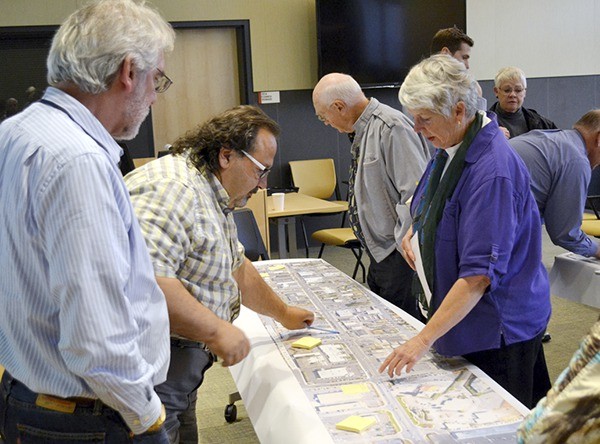There may not be many big city backups, but staff with the City of Sequim are eyeing solutions for congestion issues particularly at the Sequim Avenue and Washington Street intersection.
City staff and traffic consultants presented findings from a May traffic study on June 23 in the Sequim Civic Center to 10 residents and Sequim City Councilor Ted Miller.
Victor Salemann, principal for Transportation Solutions Incorporated out of Redmond, said Sequim has a multi-legged stool.
“When you saw one leg off something else happens,” he said. “So as we look at east/west congestion and we minimize that, we could possibly increase north/south congestion.”
Salemann said similar challenges could arise from possible solutions such as adding more left turn green arrows for the north/south intersections could add congestion on the east/west. Similarly, adding turn lanes could add vehicle capacity at an intersection but the city could be sacrificing “sensitive” downtown parking for a turn lane, he said. If added, pedestrians crossing the intersection still could impede when a vehicle wants to turn, too.
Salemann’s analysis stems from the traffic study where the Sequim Public Works Department placed low-resolution cameras on signal poles along West Washington Street collecting traffic data.
Possibly the most significant finding from the investigation is that a cable from the Sequim Avenue/Washington Street traffic signal was severed and not communicating with the rest of the traffic lights on Washington Street. Salemann said the cable likely was cut unknowingly during a construction project near the intersection but fixing it should improve the traffic flow.
As for the traffic system as a whole, he said it’s functioning but outdated.
“When a vehicle approaches the stop bar, the controller identified the car was there,” he said. “It would switch at north/south as soon as possible.”
However, he said when a vehicle going east or west looks to turn, it’s not the most efficient.
“We learned that when one car wants to go left, it stops westbound traffic, which is great for one car but slowed down 20 other cars,” Salemann said.
Crash data
The study revealed traffic peaked around noon daily and that traffic capacities were increasing along Washington Street compared to studies done in 2012 and 2014.
“Most folks are driving mid-day when it’s nice out but they are still hitting each other (in collisions) for some particular reason,” Salemann said.
Looking at collision data along Washington Street from Sequim Avenue to Seventh Avenue over the past five years, he said there were 35 wrecks resulting in non-fatal injuries.
At the Sequim Avenue/Washington Street intersection there were 22 wrecks over the span, seven wrecks at Second Avenue and Washington Street, eight wrecks at Third Avenue, two at Fourth Avenue, 25 at Fifth Avenue and 21 at Seventh Avenue. In the five-year span, two pedestrians were hit along Washington Street, too.
Of the wrecks, Salemann said 77 percent occurred in dry conditions, 89 percent were during daylight and that most of them were rear-end crashes.
“It’s unusual. A majority of the crashes are during the day and in dry conditions, which is opposite of what we usually find,” he said.
One audience member spoke up saying, “Old people don’t go out at night.”
Other findings
The city’s study also revealed that pedestrian traffic is high enough at intersections and mid-block crossings to impact traffic flow, Salemann said.
For pedestrian crossings, the east/west signals typically trigger automatically, but north/south crossings’ pedestrian buttons must be pushed.
On-street parking doesn’t impact traffic flow much though, Salemann said, because drivers aren’t bothering to parallel park or they remain parked for a long time.
Salemann added that some items like curb ramps, signs and striping were current when installed but some are not up-to-date with today’s standards.
To rectify this and other issues, the City of Sequim, with the consultants’ help, seek to apply for a grant from the Department of Transportation’s 2016 innovative Safety Program where $25 million is available for items such as increasing traffic signals operations.
Sequim City Engineer Matt Klontz said he feels the city will be competitive in the grant application process. Applications for a grant are due July 31.
Sequim Public Works Director David Garlington said going forward, the consultants will create a plan from the study and input from the public workshop. The plan will be presented to Sequim city councilors at an unknown date in a study session to consider placing needed items on a capital projects list.
Part of the list may include input from residents at the public workshop. Topics of concern ranged from crosswalks being relocated to adding turn lanes to increasing pedestrian safety at certain intersections.
For more information on the traffic study, call the City of Sequim Public Works Department at 683-4908.


